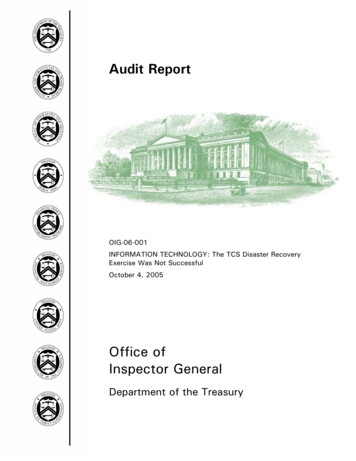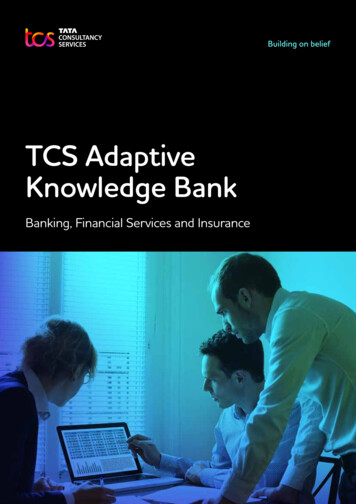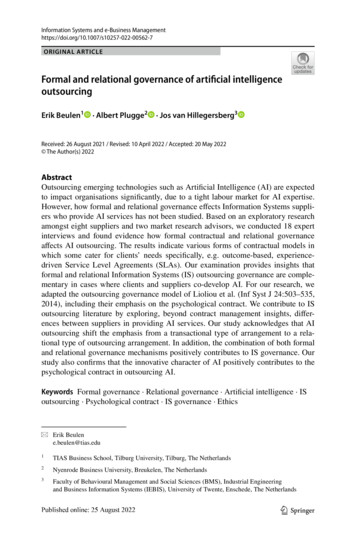
Transcription
Audit ReportOIG-06-001INFORMATION TECHNOLOGY: The TCS Disaster RecoveryExercise Was Not SuccessfulOctober 4, 2005Office ofInspector GeneralDepartment of the Treasury
ContentsAudit Report. 3Results In Brief. 3Background . 4Findings and Recommendations . 6TCS’ Disaster Recovery Process Was Not Successful. 6Recommendations. 7Processing Prioritization Scheme Not In Place. 7Recommendations. 9Other Issues For Consideration dix1:2:3:4:5:Objective, Scope, and Methodology .11TCS’ Actions Addressing Prior Audit Recommendations .12Management Comments.15Major Contributors.19Report TEOAFTreasuryWANOffice of Inspector GeneralTreasury Communications EnterpriseTreasury Communications SystemTCS Backup Facility in Martinsburg, West VirginiaTCS McLean, VirginiaTreasury Executive Office for Asset ForfeitureDepartment of the TreasuryWide Area NetworkThe TCS Disaster Recovery Exercise Was Not Successful (OIG-06-001)Page 1
This Page Intentionally Left Blank.The TCS Disaster Recovery Exercise Was Not Successful (OIG-06-001)Page 2
AuditReportOIGThe Department of the TreasuryOffice of Inspector GeneralOctober 4, 2005Ira L. HobbsChief Information OfficerDepartment of the TreasuryOur overall objective for this audit was to determine if theDepartment of the Treasury (Treasury) could successfully performits disaster recovery capability for its telecommunication systems(TCS) operations. To accomplish this objective, we observed themost recent disaster recovery exercise (DRE) to determine ifdeficiencies identified in prior reports1 were corrected.2The disaster recovery test was performed at the backup facility inMartinsburg, West Virginia (TCS-MCC) on August 17 and 18,2005. A more detailed description of our objectives, scope, andmethodology is provided in Appendix 1.Results In BriefTreasury was unable to successfully transfer and sustain theprocessing of TCS services at the backup facility for all of theTreasury bureaus and the related component agencies. Of the fiverecommendations identified in our prior report, Treasury attemptedto address the following two: Conduct a disaster recovery exercise during a peakutilization period that includes all TCS componentsAudit of Treasury Communications System Automated Information System Security Program, datedFebruary 1999 (OIG-99-039)Lack of Bureau Connectivity Remains A Weakness In Treasury’s Communications System’s DisasterRecovery Capability, dated April 2003 (OIG-03-079)INFORMATION TECHNOLOGY: The Treasury Communications System’s Disaster Recovery CapabilityHas Improved, dated May 2005 (OIG-05-038)2See Appendix 2 of this report for a detailed description of the previous OIG report finding,recommendations, management’s response to the recommendations, and actions taken during thisdisaster recovery exercise to implement the recommendations.1The TCS Disaster Recovery Exercise Was Not Successful (OIG-06-001)Page 3
requiring connection to TCS in the event of a servicedisruption andEstablish a prioritization plan that provides guidance forshutting down low priority bureaus or systems.In addition, because Treasury Executive Office for Asset Forfeiture(TEOAF) systems are linked to the DO LAN, the followingrecommendation is no longer relevant: Ensure that TEOAF has established a backup connectionto TCC-MCC and is tested in a disaster recovery test.In our previous report, we identified other issues that warrantedconsideration for TCS’ disaster recovery capability. These issuesdid not have an impact on prior or current disaster recoveryexercises. However, one of the areas remains a concern: thefuture plans to replace current TCS architecture with the TreasuryCommunications Enterprise (TCE).BackgroundTCS is a nationwide data network whose mission is to providebest-cost, secure, robust, and reliable telecommunications servicesto the Treasury and its associated bureaus and business partners.This supports the mission of promoting a stable United States andglobal economy through active governance of the financialinfrastructure of the United States Government. TCS offers acomplete range of information technology services through itsservice providers. In February 1999, the OIG issued an audit reportciting TCS’ lack of a backup facility as a material weakness. Inresponse, Treasury developed a remediation plan to assist inestablishing a disaster recovery site to support TCS’ Continuity ofOperations Plan. The remediation plan was implemented in threephases beginning in January 2002. An acceptance test wasconducted at the end of the first two phases to evaluate whetherdisaster recovery capabilities and critical system functionalitieswere working as designed.In May and October 2002, we observed the acceptance testing forphases one and two conducted at the primary site in Mclean,The TCS Disaster Recovery Exercise Was Not Successful (OIG-06-001)Page 4
Virginia (TCS-W2) and TCS-MCC.3 We found that TCSmanagement had taken actions to remedy the material weaknessby establishing a backup facility at TCS-MCC. In addition, TCSmanagement succeeded in recovering critical systems duringacceptance testing. Although disaster recovery capabilities existedfor TCS, we identified a number of weakness that needed to beaddressed: Bureaus had not established connectivity to TCS-MCC toensure networking services would not be interrupted in theevent of a disaster.Performance testing was not conducted for systems atTCS-MCC.Disaster recovery exercises were not conducted, anddisaster recovery standard operating procedures were notdocumented.Access to the Network Operating Center at TCS-MCC wasnot restricted.TCS management concurred with all OIG findings andrecommendations and commenced efforts to implement ourrecommendations. In addition, we stated that Treasury mayconsider downgrading the material weakness associated with thelack of TCS’ backup facility when (1) all bureaus have establishedconnectivity to TCS-MCC, and (2) disaster recovery exercises aresuccessfully conducted.In June 2004, we observed the TCS disaster recovery exercise atTCS-MCC.4 Although significant progress was made, the followingfindings were identified: A lack of full bureau participation,A processing prioritization scheme was not established,andTEOAF has no backup connection to TCS.Lack of Bureau Connectivity Remains A Weakness In Treasury Communications System’s DisasterRecovery Capability, dated April 2003 (OIG-03-079).4INFORMATION TECHNOLOGY: The Treasury Communications System’s Disaster Recovery CapabilityHas Improved, dated May 2005 (OIG-05-038)3The TCS Disaster Recovery Exercise Was Not Successful (OIG-06-001)Page 5
Findings and RecommendationsFinding 1TCS’ Disaster Recovery Exercise Was Not SuccessfulThe disaster recovery exercise, which officially began onWednesday, August 17, 2005,5 was aborted on August 18, 2005because of the inability to establish and maintain connectivity andprovide the services to the Treasury’s bureaus and componentsfrom the backup facility. On August 18, 2005, TCS personnelinformed us that the test was aborted at 5:00 a.m. due to asystem failure that occurred overnight. In addition, althoughdiagnostic equipment showed no anomalies, some bureaus reporteddisruptions in internet and email services. For example, a numberof emails sent after 4:00 PM on August 17, 2005 did not arrive totheir destinations in a timely manner. In some instances, theseemails arrived to their destinations three days after sending as aresult of the direct intervention of system administrators.The exercise was conducted to comply with the FederalPreparedness Circular 65 which requires the annual testing of theFederal Executive Branch’s continuity of operations to ensurereadiness. The TCS’ disaster recovery exercise was conducted aspart of this annual assessment.Some of the bureaus/components were switched to TCS-MCC prior to this date due to workloadconsiderations.5The TCS Disaster Recovery Exercise Was Not Successful (OIG-06-001)Page 6
RecommendationsThe Treasury CIO should:1. Determine the cause(s) of the inability to complete the disasterrecovery exercise and implement necessary corrections orupgrades to ensure that the backup facility will operateadequately during future DREs or during actual disasters.2. After the cause(s) is (are) identified and corrected, conduct aDRE during a peak utilization period that includes all TCScomponents requiring connection to TCS in the event of aservice disruption.Management Response Management agreed with therecommendations. The TCS contractor provided management witha final After Action report which identified the root causes of thedisaster recovery exercise service disruption. The report providedspecific remediation maintenance actions that have been completedto prevent outages of this nature in the future. After all of thefindings in this audit report, the After Action report, and the TCSinternal assessment have been completed, a full disaster recoveryexercise will be conducted. The exercise will be completed no laterthan September 30, 2006.OIG Comment The actions taken and planned by the Office ofInformation Systems are responsive to the intent of ourrecommendations.Finding 2Processing Prioritization Scheme Not In Place6A component prioritization scheme was not established in theevent that a processing overload occurs at TCS-MCC. TCS doesnot currently have a finalized prioritization plan that would provideguidance for shutting down low priority bureaus or systems. Inaddition, bureau level prioritization guidance has not been adoptedto assist bureaus in prioritizing their systems for recovery in theevent of a disaster. We were provided with a draft plan titledManaging Electronic Communications During Emergencies –This was noted in the previous report. Since TCS has not fully addressed this issue and did notconsider it part of this exercise, we are including it with updated information in this report.6The TCS Disaster Recovery Exercise Was Not Successful (OIG-06-001)Page 7
MINIMIZE which was dated July 6, 2005. The draft planestablishes the purpose, policy, authority, and activation toimplement the plan. The plan also includes the requirement that allTreasury Bureaus shall establish and maintain a prioritized list ofcritical systems and critical information flows. The draft plan isbefore the CIO Council for their review. However, no formal actionhas been taken on the plan.In addition, there is no policy or process on how a networkoverload at TCS-MCC would be managed over longer periods oftime (versus an immediate recovery). Currently, if this situationoccurs, TCS management would provide network usage analysis toTreasury senior management exclusively for direction on handlingbureau/system prioritization.OMB Circular A-130, “Management of Federal InformationResources”, establishes policy for the management of federalinformation resources. Appendix III, “Security of FederalAutomated Information Resources”, of this circular establishes aminimum set of controls to be included in federal automatedinformation security programs. According to Appendix III,managers should plan for how they will perform their missionand/or recover from the loss of existing application support, anddetermine whether the loss is due to the inability of the applicationto function or a general support system failure. They shouldestablish and periodically test the capability to continue providingservices within a system based upon the needs and priorities of theparticipants of the system. Experience has demonstrated thattesting a recovery plan significantly improves its viability. Untestedplans, or plans not tested for a long period of time, may create afalse sense of ability to recover in a timely manner.Since TCS is the conduit for disseminating Treasury informationand data, any major TCS service disruption can impede bureaus’operations and missions. In the event of a disaster, inadequaterecovery capabilities would cause mission critical operations tocease. Therefore, the cause of the system failure must bediscovered and repaired to ensure an orderly transition of servicesin the event of a disaster.The TCS Disaster Recovery Exercise Was Not Successful (OIG-06-001)Page 8
RecommendationsThe Treasury CIO should:3. Establish a prioritization plan that provides guidance for shuttingdown low priority bureaus or systems.4. Ensure that bureaus identify what systems are critical and whatTCS needs to recover in the event of a disaster.5. Establish a policy that identifies how a system overload at TCSMCC would be managed over longer periods of time.Management Response Management agreed with therecommendations. Corrective measures for recommendation threeinclude developing and distributing guidelines for bureaudevelopment of prioritization of their circuits and applications.Once the guidelines are developed, an action plan will be developedfor evaluating bureau responses; developing a comprehensive,overarching enterprise prioritization plan; and implementing it. Theaction plan will be developed through the Telecommunications SubCouncil of the Treasury CIO Council. Corrective measures forrecommendations four and five include revising the TCS Continuityof Operations Plan and Disaster Recovery plans to include (1)identification of systems that are critical to bureaus and a plan forrecovering them in the event of a disaster and (2) include a policyon managing system overload over extended periods of time. Thismay entail monitoring traffic growth over TCS and working withbureaus on sizing.OIG Comment Since the response did not specify that the bureauswould identify which systems are critical, it did not appear that theresponse for item four conformed to the recommendation. TheCIO’s office confirmed that the bureaus would be identifying whichsystems are critical. This will be accomplished through theTreasury Telecommunications Sub-Council, which is composed ofrepresentatives from the various bureaus. Therefore, the actionstaken and planned by the Office of Information Systems areresponsive to the intent of our recommendations.The TCS Disaster Recovery Exercise Was Not Successful (OIG-06-001)Page 9
Other Issues For ConsiderationIn our previous report, we identified other areas of considerationthat, although did not directly impact the disaster recovery exerciseor TCS’ functionality, need to be considered as part of TCS’ futureoperations. To date, there is still no the current plan to transitionTCS operations to a new communications infrastructure.TCS management planned to migrate its current TCS operations tothe TCE communications environment. The contractor responsiblefor maintaining the functionality of TCS has approximately onemonth remaining on its current contract. An automatic 6-monthextension can be granted on the contract; however, once thecurrent contract expires, IRS will request a 12-month extension.Treasury is in the process of procuring TCE which will replace TCS.The objective of the TCE contract is to improve TCS services byenhancing or replacing current infrastructure, assets, and services.To ensure continuity of operations, it is essential that Treasuryensures a well planned transition to sustain the viability of TCS’day-to-day operations, as well as disaster recovery capability. Thelack of a sound transition process could lead to a disruption in theservice TCS provides to the bureaus.******I would like to extend my appreciation to TCS for the cooperationand courtesies extended to my staff during the review. If you haveany questions, please contact me at (202) 927-5774, orRichard Kernozek, IT Audit Manager, Office of InformationTechnology Audits, at (202) 927-7135. Major contributors to thisreport are listed in Appendix 5.Louis C. KingDirector, Office of Information Technology AuditsThe TCS Disaster Recovery Exercise Was Not Successful (OIG-06-001)Page 10
Appendix 1Objective, Scope, and MethodologyThe objectives of this audit were to determine if the Departmentimplemented our prior audit recommendations and to assess theDepartment’s disaster recovery capabilities for the TCS Mcleanfacility7. These objectives were accomplished by (1) observing thedisaster recovery exercise which took place from August 17h to18h, 2005 at TCS-MCC; (2) interviewing appropriate IT personnel;(3) reviewing disaster recovery exercise reports provided byTreasury; (4) reviewing and analyzing Treasury’s planning, resultsand post-exercise documentation; and (5) analyzing limited e-mailtraffic during the disaster recovery exercise. Since the exercisewas aborted, bureau locations within the Washington, D.C. areawere not reviewed.We used the Federal Preparedness Circular 65 and OMB Circular A130 as criteria to assess the results of the exercise. Fieldwork wasperformed at TCS-MCC during August 2005. We conducted ourwork in accordance with Generally Accepted Government AuditingStandards.7This audit was included in the OIG’s Annual Plan Fiscal Year 2005 on page 28.The TCS Disaster Recovery Exercise Was Not Successful (OIG-06-001)Page 11
Appendix 2TCS’ Actions Addressing Prior Audit RecommendationsA backup facility at TCS-MCC has been established. In our May 16, 2005 report, weidentified weaknesses in TCS’ disaster recovery capabilities that would impact TCSand Treasury bureaus in the event of a disaster or unplanned disruption at TCS-W2.As a result, we provided five recommendations to the CIO. The recommendations,CIO management response, and action taken during this disaster recovery exercise arespecifically identified below.Recommendation 1: Conduct a disaster recovery exercise during a peak utilization period thatincludes all TCS components requiring connection to TCS in the event of a service disruption.Management Response: Management agreed to conduct a full disaster recovery test once all of thebureaus were connected to the backup site.Actions Taken Prior To And During The Exercise: The Director, Infrastructure Operations sent an email to the bureaus and components apprising them of the disaster recovery exercise which wasscheduled for August 17-19, 2005. The e-mail stated that this disaster recovery exercise wouldinvolve an almost total power-down of the TCS-W2 facility to more realistically reflect the disasterrecovery procedures in the event of catastrophic damage to the primary facility. The e-mail furtherstated that the exercise would include a review of the “prioritization plan” to maintain minimumservice levels in extraordinary circumstances. However, the information we obtained during theexercise in-brief stated that a review of this plan was not included in the exercise.The TCS Disaster Recovery Exercise Was Not Successful (OIG-06-001)Page 12
Appendix 2TCS’ Actions Addressing Prior Audit RecommendationsRecommendation 2: Establish a prioritization plan that provides guidance for shutting down lowpriority bureaus or systems.Management Response: Management indicated that they would develop a Treasury prioritizationplan and related directive to ensure bureaus and offices shut down low priority systems duringtimes of emergency.Actions Taken Prior To And During The Exercise: A draft plan, titled Managing ElectronicCommunications during Emergencies – MINIMIZE and dated July 6, 2005, has been forwarded tothe CIO Council for comment. Documentation provided at the in-brief meeting indicated thatinclusion of this recommendation was not part of the exercise.Recommendation 3: Ensure that bureaus identify what systems are critical and what TCS needs torecover in the event of a disaster.Management Response: Management stated that they would identify critical systems and providethe TCS program management office with a prioritized list.Actions Taken Prior To And During The Exercise: Documentation provided at the in-brief meetingindicated that inclusion of this recommendation was not part of the exercise.Recommendation 4: Establish a policy that identifies how a system overload atTCS-MCC would be managed over longer periods of time.Management Response: Management agreed to monitor the growth of TCS traffic and work withthe bureaus to ensure they adequately size their alternate communication paths.Actions Taken Prior To And During The Exercise: Documentation provided at the in-brief meetingindicated that inclusion of this recommendation was not part of the exercise.The TCS Disaster Recovery Exercise Was Not Successful (OIG-06-001)Page 13
Appendix 2TCS’ Actions Addressing Prior Audit RecommendationsRecommendation 5: Ensure that TEOAF has established a backup connection to TCS-MCC and istested in a disaster recovery test.Management Response: Management informed the OIG that TEOAF was no longer connecteddirectly to TCS for its primary WAN services. It receives its connectivity from IT Headquarters andthe Departmental Offices local area network maintains disaster recovery connectivity.Actions Taken Prior To And During The Exercise: No additional action necessary.The TCS Disaster Recovery Exercise Was Not Successful (OIG-06-001)Page 14
Appendix 3Management CommentsThe TCS Disaster Recovery Exercise Was Not Successful (OIG-06-001)Page 15
Appendix 3Management CommentsThe TCS Disaster Recovery Exercise Was Not Successful (OIG-06-001)Page 16
Appendix 3Management CommentsThe TCS Disaster Recovery Exercise Was Not Successful (OIG-06-001)Page 17
Appendix 3Management CommentsThe TCS Disaster Recovery Exercise Was Not Successful (OIG-06-001)Page 18
Appendix 4Major ContributorsOffice of Information Technology AuditsLouis C. King, DirectorRichard G. Kernozek, IT Audit ManagerLeslye K. Burgess, IT Audit ManagerCharles Dampare, IT AuditorCatherine Yi, ReferencerThe TCS Disaster Recovery Exercise Was Not Successful (OIG-06-001)Page 19
Appendix 5Report DistributionThe Department of the TreasuryOffice of the Deputy Assistant Secretary for InformationSystems/Chief Information OfficerOffice of Accounting and Internal ControlEnterprise Communications Program Management OfficeOffice of Management and BudgetOffice of Inspector General Budget ExaminerThe TCS Disaster Recovery Exercise Was Not Successful (OIG-06-001)Page 20
The disaster recovery test was performed at the backup facility in Martinsburg, West Virginia (TCS-MCC) on August 17 and 18, . 2005. A more detailed description of our objectives, scope, and methodology is provided in Appendix 1. Results In Brief Treasury was unable to successfully transfer and sustain the processing of TCS services at the .










